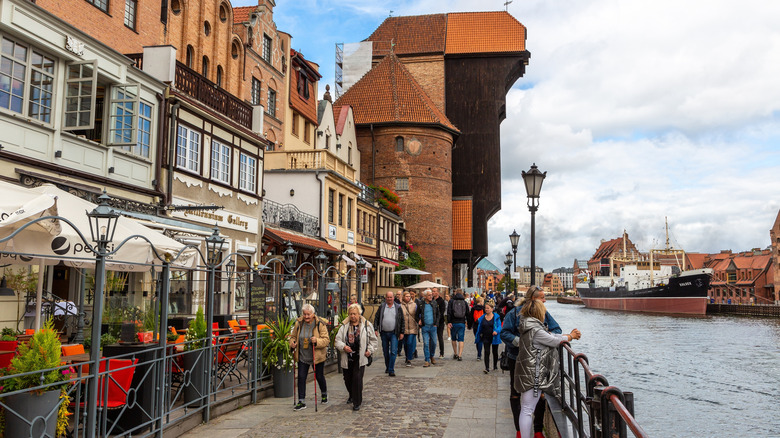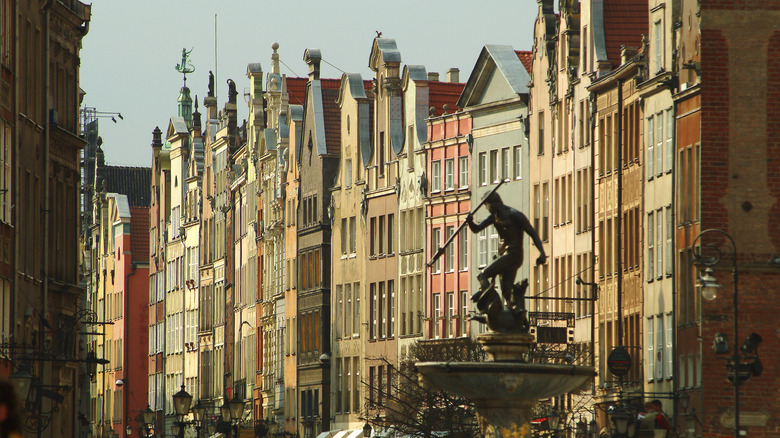Rick Steves Says 'Europe's Greatest Still-Undiscovered Destination' Is Hiding In Plain Sight
Eastern European countries are often characterized as underdeveloped, with cities full of harsh Brutalist architecture and meals comprised of only cabbage and potatoes. Poland — known mostly to travelers as the tragic epicenter of WWII — perhaps isn't the first place that comes to mind when planning your cheery European vacation. However, the beautiful country is much more than its sordid past. With intricately designed architecture, amazing museums, delicious food, and a culture that thrives on thousands of years of tradition, this country should be added to any history and culture lover's European bucket list.
Author and European travel expert, Rick Steves, suggests that one undiscovered city should receive far more recognition as a travel destination than it currently does. Gdańsk, Poland, is a quaint historical city set on the Baltic Coast. Germany's invasion of Gdańsk is what marked the beginning of WWII, but the city is also where the anti-authoritarian Solidarity movement began in the 1980s, which ultimately about the beginning of the end of the Cold War. This city provides not only the opportunity to delve into Poland's past, but also a chance to look at its resilience. As Steves explains, many people who picture this city think it to be a "wasteland of rusted, smoke-belching shipyards," but that's simply not the case.
While it's true that Gdańsk holds one of Poland's largest shipyards, colorful buildings line the historic Old Town, small cobbled alleyways lead to delicious mom-and-pop restaurants, and history pours out of every door. This is the kind of city where every step reveals something unexpected. As Steves says, Gdańsk "may well be Europe's greatest still-undiscovered destination." Whether you're a history lover, a foodie, or an architecture enthusiast, Gdańsk offers layers upon layers of experiences waiting to be enjoyed.
Exploring Gdańsk's Old Town
If there's one place visitors should spend the majority of their time exploring in Gdańsk, it's the Old Town. According to Rick Steves, "the old town is a gem, boasting block after block of red-brick churches and ornately decorated mansions." Once, nearly 80% of this beautiful area was destroyed by the bombings of WWII, but the citizens of Gdańsk took it upon themselves to rebuild brick by brick. The main draw of today's Old Town is the Royal Route (aka Long Street), where visitors can find unique monuments and buildings within walking distance. This part of Gdańsk features pastel-hued merchant homes, intricate facades, and bustling restaurants.
A must-see attraction along this walk is the Main Town Hall, where you can enjoy panoramic views of the city and explore the Museum of Gdańsk on-site. Neptune's Fountain is Gdańsk's most popular landmark, St. Mary's Basilica remains the largest Gothic brick church in the world, and Artus Court was once a meeting place for merchants and nobles, but is now a museum showcasing unique antiques. Behind St. Mary's sits Mariacka Street — a quaint cobbled road lined with antique homes and authentic Baltic amber shops.
From here, visitors can walk along the Motlawa River waterfront to admire beautiful buildings and a 15th-century medieval port crane that was once the largest working crane in the world. It now sits as part of the National Maritime Museum, where you can explore its inner mechanisms and learn more about Gdańsk's role as a key port city. For those interested in learning more about its history, visitors can head to Gdańsk's Museum of the Second World War, which provides a comprehensive look into the conflict.
Dine on some delicious Polish specialities in Gdańsk
If you've never been to Poland, one thing you should know is you can forget about any diet you're on. Polish food is savory, and let's be honest — a bit fatty. But that's what makes it so delicious! Rick Steves recommends Poland as a must-visit destination for adventurous foodies. Visitors must try pierogies, dumplings typically stuffed with cheese and potatoes, and placki ziemniaczane, fried potato pancakes served with sour cream, similar to latkes. Kaszanka, a buckwheat and pork sausage, bigos, a hearty cabbage stew, and pickled herring are also traditional Polish fare. If you're visiting on a budget or just want to immerse yourself in a real Polish experience, try a milk bar — cheap cafeterias serving up hearty plates of Polish specialties. According to Steves, these are "an essential Polish sightseeing experience."
The best time of year to visit Gdańsk is typically May through September if you want to enjoy warmer weather, outdoor dining, and the nearby beaches. December is a beautiful time to visit, especially to see the Christmas Market, and October through April offer quiet (albeit cold) times for exploration. Getting to Gdańsk from other major cities is fairly simple. Trains from Warsaw take about 2.5 hours, and the Gdańsk Lech Wałęsa Airport, which services direct flights to destinations all over Europe, is only 7 miles from the city center. Spending a day in Gdańsk is like stepping back in time — you can feel the history pulsating through every corner of this proud city. Whether you're enjoying some delicious pierogies with the feel of the sea breeze in your hair or taking in the intricately designed architecture, Gdańsk is a place that you'll want to return to time and time again.


